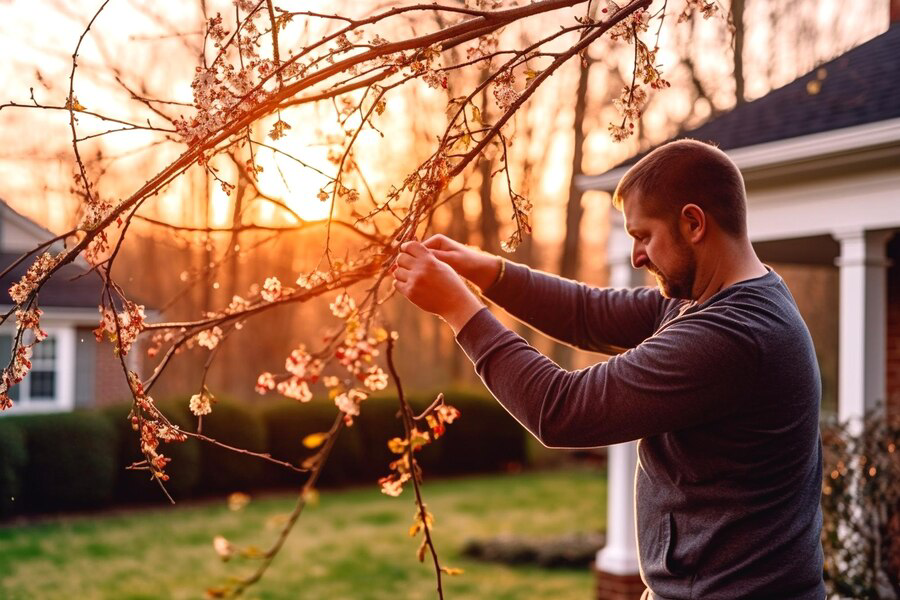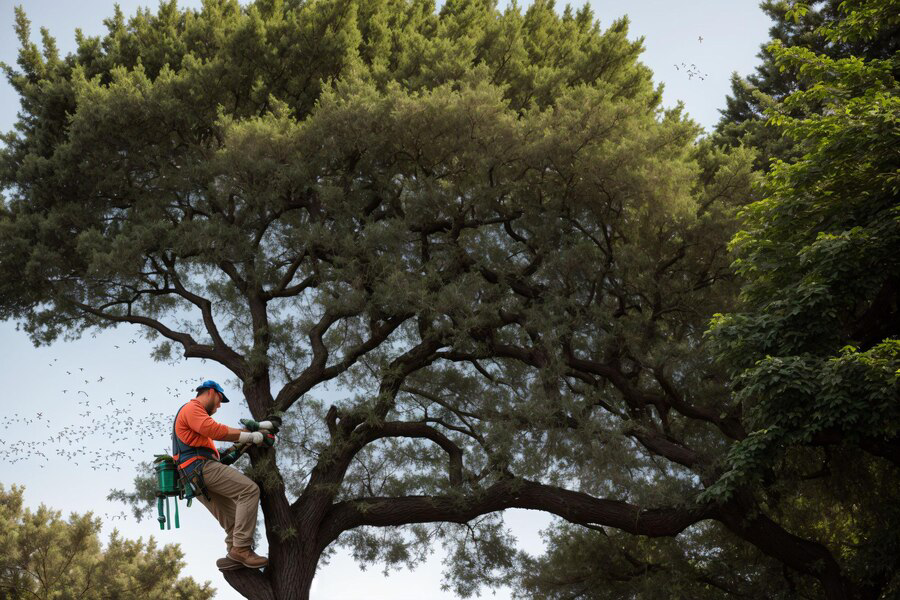Are you confused about whether your tree needs trimming or pruning? While the two terms are often used interchangeably, they have different meanings and purposes. Tree trimming involves removing overgrown branches to improve the appearance of the tree, while tree pruning is a more focused approach that removes diseased or weakened limbs to promote healthy growth. In this blog, we will explore the differences between tree trimming and pruning, as well as the benefits of regular maintenance for your trees. We will also discuss how these processes complement each other and why it is essential to consider professional services for your trees. Keep reading to learn more about how to keep your trees healthy and beautiful all year round.
Understanding Tree Trimming
Trimming trees is essential for their healthy growth and to allow sunlight penetration. It’s a landscaping technique that enhances the overall health of mature trees. By removing dead branches through proper tree trimming techniques, the risk of branches falling and causing damage is minimized. Additionally, trimming promotes air circulation and prevents diseases that can negatively impact tree health. Timing tree trimming based on the blooming cycle of the tree ensures optimal results. Homeowners can use the best tools and techniques or seek professional services for tree trimming, such as those available in Dallas.

The Purpose of Tree Trimming
Tree trimming serves several important purposes for the health and safety of your trees. By trimming overgrown branches, you can enhance tree health and promote new growth. Additionally, trimming allows you to maintain lower branches, ensuring safety on your property. It also helps to prevent branches from growing into power lines, reducing the risk of electrical hazards. Furthermore, tree trimming increases fruit yields in fruit trees by promoting proper sunlight penetration and circulation. To accomplish effective tree trimming, it’s best to use the appropriate tools and techniques based on the time of the year and the specific needs of your mature trees.
Techniques Used in Tree Trimming
When it comes to tree trimming, using proper tools is essential to ensure the best results. Hand shears are commonly used for tree trimming, allowing for precise cuts and minimizing damage to the tree. Different plant species require specific techniques for trimming to promote healthy growth and longevity. Timing is also crucial for safety and tree health. Trimming trees at specific times of the year reduces the risk of branches falling and allows for new growth to flourish. For fruit trees, pruning is necessary to encourage flower production and maximize fruit growth. These techniques, when done correctly, contribute to the overall health and aesthetic appeal of mature trees.
Unpacking Tree Pruning
Tree pruning involves shaping the tree canopy for aesthetic purposes and ensuring the health of the tree. It is essential to remove diseased branches and pests, as well as maintain the bark’s health through proper techniques. Pruning trees during the flowering season enhances bloom production. Proper tree pruning techniques also help in the growth of new lateral branches. Mature trees can benefit from tree pruning to prevent the risk of branches causing damage or posing a safety hazard. Homeowners in Dallas should consider tree pruning as part of their landscaping techniques to ensure the long-term health and beauty of their trees.
The Role of Tree Pruning
Pruning trees plays a vital role in promoting their overall health and growth. By strengthening tree branches, pruning helps ensure strong and sturdy growth. It also aids in developing a proper branch structure, which is crucial for the tree’s stability and aesthetics. Additionally, pruning smaller shrubs and foliage improves tree health by allowing better airflow and moisture circulation. This promotes canopy growth and prevents the risk of branches becoming overgrown or bearing dead buds. Homeowners can use the best tools and employ proper tree pruning techniques to maintain the health and longevity of their mature trees.
Common Methods for Tree Pruning
There are various methods for tree pruning. Pruning shears are used for smaller shrubs and foliage. Saws are often used for crown reduction pruning. Crown cleaning involves removing dead or diseased branches. Canopy reduction is achieved by trimming branches in different directions. Clipper trimming is used for hedge pruning. These methods promote tree health and prevent branch falling.
Comparing Tree Trimming and Tree Pruning
Tree trimming focuses on promoting the overall health of your trees by removing loose branches and ensuring proper growth. On the other hand, tree pruning techniques shape the tree canopy and branches, enhancing their appearance. Both tree trimming and pruning services play a crucial role in enhancing tree longevity and maintaining the safety of your property. While tree trimming targets the removal of problematic branches, tree pruning targets specific growth and development. It’s important to consider the best tools and landscaping techniques for both processes. Whether you have mature trees or are a homeowner in Dallas, tree trimming and pruning should be done at the right time of the year to minimize the risk of branches and tree removal.

Key Differences Between Tree Trimming and Pruning
When it comes to tree maintenance, there are key differences between tree trimming and pruning. Tree trimming involves the removal of extra branches, ensuring the safety of your property by getting rid of any risk of branches falling. On the other hand, tree pruning techniques target specific branches for the overall health of the tree. It focuses on the blooming cycle of the tree, shaping the tree canopy for aesthetic purposes. Both tree trimming and pruning play important roles in maintaining the longevity of mature trees. While tree trimming utilizes the best tools, proper tree pruning techniques require knowledge of landscaping techniques. Homeowners in Dallas should consider both tree removal and tree pruning services to ensure their trees stay healthy and beautiful year-round.
Tools and Equipment Required for Both Processes
Tree trimming services rely on power trimmers to efficiently trim trees, ensuring the removal of excess branches. On the other hand, tree pruning techniques utilize saws for the proper removal of branches in a precise manner. Hand shears are used during tree pruning for precision trimming. Electric trimmers are essential tools for tree trimming, as they ensure safety and accuracy during the process. For proper tree pruning, specific tools such as saws and shears are required to shape the tree canopy and promote optimal growth. These tools and equipment play a crucial role in both tree trimming and pruning processes.
The Synergy Between Tree Trimming and Pruning
Tree trimming and pruning services work hand in hand to enhance the overall health of your trees. By regularly trimming and pruning your trees, you can promote a healthy canopy and ensure the long-term care of your trees. Additionally, this coordinated effort helps to maintain the safety of your property over time. Combining both tree trimming and pruning techniques allows for comprehensive tree care, addressing the specific needs of your trees. With the use of the best tools and proper techniques, such as removing risk branches and encouraging new growth, you can effectively enhance the beauty and vitality of your landscape.
How Trimming and Pruning Complement Each Other
Trimming and pruning are essential for maintaining healthy trees. Trimming enhances aesthetics and promotes new growth, while pruning ensures overall well-being by removing dead or diseased branches. Regular trimming and pruning encourage healthy growth and reduce the risk of branches posing a threat to your property. To achieve optimal results, use the best tools and follow proper techniques.
The Impact of Timing and Frequency on Tree Health
Proper timing and frequency are crucial for tree health. Each tree species has specific trimming and pruning times. Regular, timely trimming and pruning promote long-term tree health. Avoid over-trimming or pruning to prevent harm. Consult a certified arborist to determine the best timing and frequency based on factors like new growth and branch risk. Follow proper timing and frequency to enhance your landscaping techniques and ensure tree well-being.
The Benefits of Regular Tree Trimming and Pruning
Regular tree trimming and pruning offer numerous benefits for your trees. Firstly, they improve the appearance and shape of your trees, making them more aesthetically pleasing. Additionally, trimming and pruning enhance sunlight penetration and air circulation, which are essential for promoting tree health. By removing dead branches through trimming and pruning, you can prevent the risk of pests and diseases that thrive on decaying wood. Moreover, regular trimming and pruning support strong growth, leading to increased fruit yields and flower production. Finally, proper tree trimming and pruning techniques contribute to the longevity of your trees, ensuring they remain healthy and vibrant for a long period of time.
Should You Consider Professional Services for Your Trees?
Consider hiring professional tree trimming services to ensure the safety of your property and loved ones. Certified arborists have the expertise and tools to trim trees without causing harm. They also consider the specific needs of different tree species, can address tree health issues, and save you time, effort, and the risk of accidents.
Conclusion
In conclusion, both tree trimming and tree pruning are essential for maintaining the health and aesthetics of your trees. Tree trimming focuses on removing overgrown branches and shaping the tree, while tree pruning involves the selective removal of dead, diseased, or damaged branches to promote growth and improve structure. While you can perform basic tree trimming on your own, tree pruning requires more expertise and knowledge. It’s best to consult a professional tree service to assess the specific needs of your trees and ensure they receive the proper care. Regular tree trimming and pruning not only enhance the appearance of your trees but also contribute to their overall health and longevity. If you’re unsure which service your tree needs, contact us today for a professional assessment.











